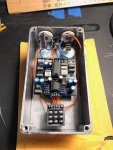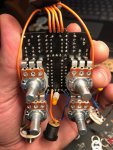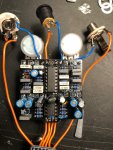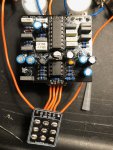soothsayer86
Member
I completed my build (second ever) and plugged everything in. I got sound when in bypass but nothing happened when I switched the pedal on. I thought maybe I had put the LED in the wrong way so I switched that around and tested again and that time I had signal through the pedal both in by pass and when engaged, but the LED didnt light and there was no effect present. I am unfortunately waiting on my multimeter to arrive so I am unable to use that to test at the moment. I am just wondering if there is an obvious issue with my build.
Also, now that I am not sure which way my LED actually is in, I was going to start with a fresh one but all I have is a two color LED with three legs. Is there any way to use this one as a single color by using only two of the legs?
Thanks in advance.




Also, now that I am not sure which way my LED actually is in, I was going to start with a fresh one but all I have is a two color LED with three legs. Is there any way to use this one as a single color by using only two of the legs?
Thanks in advance.








